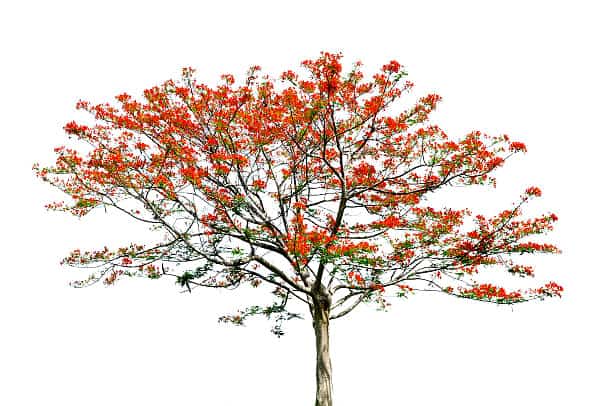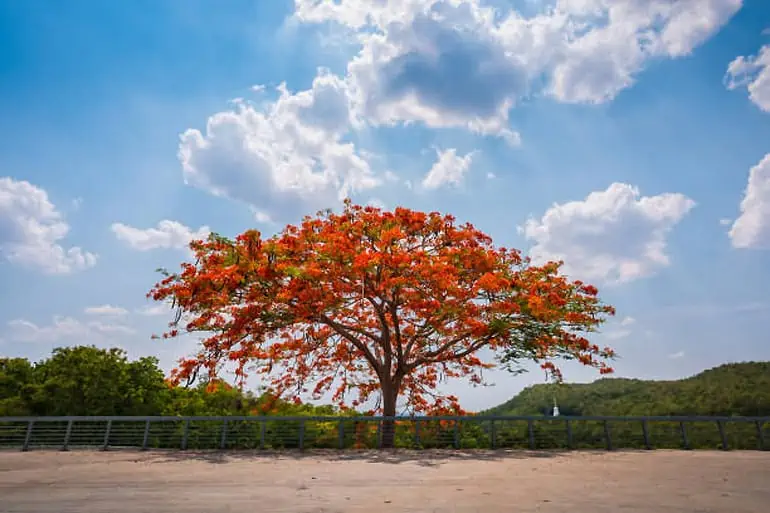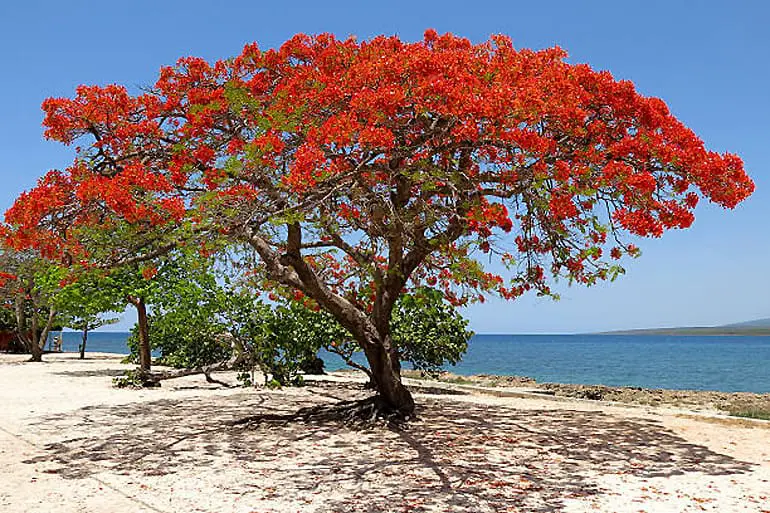Table of Contents
The flame tree also known as Royal Poinciana is a flowering plant from the Fabaceae family. The tree is native to Madagascar and is known for its leaves that look like a fern, as well as the exuberant Orange to red flowers it displays during summer. The tree is largely cultivated in the tropical and subtropical regions where it is used mainly for ornamental purposes and can grow up to 40fts tall and about 40fts wide.
Despite being a natural tall tree, the flame tree is one of the most popular trees used for bonsai by houseplants lovers and gardeners for obvious reasons: they are fast growers and would add to the original interior aesthetic appeal of a building.
Growing Flame tree Bonsai is very easy as long as you provide the tree with the appropriate treatment essential for its growth. You will find out about the care requirements of the flame bonsai tree in this article, as well as some interesting facts about the tree.
General information
| Common name | Flame tree |
| Scientific name | Delonix regia |
| Type | Tree |
| Family | Fabaceae |
| Native | Madagascar |
| Zone | 10 to 12 |
| Height | 30 to 40 |
| Spread | 40 to 70 |
| Leave | Evergreen |
| Fruit | Showy |
| Flower | Showy |
| Bloom time | June to July |
| Bloom description | Scarlet Orange |
| Maintenance | Low |
| Sun | Full sun |
| Water | Medium |
| Temperature | 50°F to 68°F |
| Soil |
Can I Bonsai Flame tree?

Yes, you can Bonsai flame tree. The flame tree is known for its beautiful Orange-red flowers and will make an excellent Bonsai specimen if trained according to the tradition. It is a fast-growing plant and requires low maintenance to stay healthy, which means it can be easily cultivated by both inexperienced and expert Bonsai collectors.
Is flame tree easy to Bonsai

Yes, it is easy to grow the Flame tree as a Bonsai. Growing a Flame tree as Bonsai is very easy and will not pose any challenge to even a Bonsai beginner. This is because the Flame tree is not too demanding in any of its care requirements. The tree can tolerate poor soil and can also handle heavy pruning.
Flame tree Bonsai history
The Flame tree originated in Madagascar and has been cultivated in many tropical and subtropical countries throughout the world. The tree is of special significance to Puerto Ricans as the flowers from the tree are used to represent their national flower and stand as a symbol of rest, pride, and hope.
According to historical accounts, the Flame tree owes its popularity to the Jibaro people of Puerto Rico. The Jibaro which in English means “mountain people” were men that worked and resided in the countryside of Puerto Rico. These people were neither rich nor educated but had natural wisdom and were highly skilled in farming and cow milking.
The flame tree became popular after a Puerto Rican girl named Awilder moved to New Britain with a picture — Canvas of El Flamboyan that was given to her by her sister. This picture containing the image of the colorful flame tree, a Jibaro man herding two cows, a house, and a banana tree was handed over to her to remind her of her root and homeland.
Many people fell in love with the picture, especially the beautiful flame tree as well as the body of information it encapsulates. This prompted people especially Puerto Ricans in the diaspora to plant the tree as a house plant to bring home close to them.
Flame tree scientific name

The scientific name of the Flame tree is Delonix regia
Is Delonix regia poisonous?
Yes, Delonix regia is poisonous. Although the roots, seeds, and leaves of Delonix Regia are used in the treatment of diseases and ailments but the seed especially when they are matured are poisonous because of their antinutrient content.
The leaves of Delonix Regia contain hydrocyanic acid and the seeds, as well as the pods, contain tannins which when ingested by pests can irritate the oral cavity, pawing at the mouth, vomiting, difficulty in swallowing, and diarrhea.
Is the Flame tree native to Australia?
No, the Flame tree (Delonix regia) is not native to Australia. However, there is a species of flame tree known as the Australian flame tree which originates from Australia.
Do flame trees from in Melbourne?
Yes, flame trees will grow in Melbourne. The Australian flame tree is also known as the Illawarra flame tree can grow in all parts of Australia, especially the Canberra region. Flame tree is a common scenery in many gardens in Melbourne.
Do flame trees have thorns?
No, flame trees do not have thorns.
Flame tree Bonsai care
The flame tree is a very attractive plant and you can’t help but notice them among a forest of trees. However, even though this tree is believed to require minimal maintenance to survive, you must keep up with its care requirement to survive. Discussed below are some of these requirements. Continue reading for details.
Flame tree Bonsai temperature
The flame trees may be lenient with their demands but when it comes to temperature requirements, you have to be careful. This is because flame trees cannot tolerate frost and therefore, you must be very watchful. Flame tree Bonsai is best raised under a temperature level of between 50°F to 68°f.
Flame tree Bonsai fertilizer
It is very easy to fertilize your Flame tree, all that is required of you is being conversant with the appropriate timing and making the right choice of fertilizer. You can feed your flame tree with either liquid or solid fertilizer however, you have to know the standard dosage for each of them.
If you are using liquid fertilizer, apply it to your plant once a week. And if you are using solid fertilizer, it is expected to be applied once in 4 weeks. Also, regardless of the type of fertilizer you choose, you should ensure balanced ingredients of NPK. Equal proportions of Nitrogen, phosphorous, and potassium will encourage healthy and vibrant bloom when your plant reaches the blooming stage.
Flame tree Bonsai pruning
Flame tree Bonsai are popular for their umbrella shape. This shape can only be achieved if it is adequately pruned.
The best tone to prune your Flame tree Bonsai is during spring. This is because during this period, flame trees normally do not have leaves on them and their branches at this time are almost naked therefore, it will be very easy for you to access branches that need to be pruned.
Cut back all wilted and damaged twigs to encourage proper growth of the tree.
Flame tree Bonsai repotting
The older the soil of your flame tree Bonsai gets, the more it loses the ability to generate nutrients for the tree. The best way this can be corrected is through repotting.
Repot your Flame tree Bonsai once in 6 or 12 months. And this should also be done during spring immediately after pruning them. Also, before you repot your tree, check the root system, structure, and health to determine if the root needs to be pruned.
Flame tree Bonsai pest and diseases
Flame trees are usually not attacked by a lot of pests and diseases. The tree is only vulnerable to attacks from the likes of spider mites, scale insects, and caterpillars.
Although caterpillars feed on the leaves on the tree and make them look unhealthy, the damages they cause are minimal as they cannot defoliate the entire tree.
On the other hand, your tree may suffer attacks from spider mites if you are raising your tree in an environment with very low humidity. If you are residing indoors and you notice spider mite infestation, increase the humidity level or relocate your tree outside.
Another insect you need to worry about is the Phellinus noxious. This fungus is known to be responsible for causing root rots in Flame trees. Using well-draining soil will help lower the chances of getting your tree infested by this notorious fungi.
Flame tree Bonsai soil
Flame tree Bonsai will grow on all types of soil as it can be successfully cultivated on loamy, sandy, clay, and gravel soil. What flame tree Bonsai cares about is proper drainage. Water the soil only when it feels dry and make sure to cover the soil around the tree after planting. Create some space close to the trunk using 2 inches layer of mulch.
Flame tree Bonsai watering
Your flame tree Bonsai will benefit a lot from watering them regularly during summer, spring, and early fall. Always endeavor to keep the soil moisturized and not soggy all through its young stage until the root becomes firmly established.
Reduce watering late before you finally stop watering altogether during winter when the usually goes dormant.
Flame tree Bonsai sunlight requirement
The flame tree loves to stay under the sun, therefore, it is advisable to place your flame bonsai tree in a location where it can be exposed to full sunlight for at least 6 hours per day. It is important to allow your tree access to enough sunlight to encourage healthy showy flowers.
Do flame tree Bonsai grow fast?
Yes, the flame tree Bonsai is a fast grower and can grow an additional 24 to 36 inches to its original height in a growing season. Eventually, at the maturity stage of the tree, it can grow as tall as 65fts and 30fts wide.
Can you grow a Flame tree Bonsai from a cutting?
Yes, you can grow a flame tree Bonsai from cuttings. However, it is best to start your Flame tree Bonsai from a seed or nursery plant because they yield the best result.
How to grow flame tree Bonsai from seed
If you have your seed in handy, you can proceed with the propagation of your Flame tree bonsai. Follow the instructions below to guide you through the process involved.
- Open the pod and remove the seeds.
- Soak the seeds in warm water for a day or two to help soften the coverings of the seeds.
- Scratch each seed with a knife to help scarify them. This will ensure that the seeds absorb enough water after planting and also encourage a speedy germination process. Alternatively, you can also scratch the seeds with sanding paper. Do this just for a few seconds!
- Pour a well-draining soil mix into a seed tray that is 3 to 6 inches deep.
- Plant each seed 1 inch deep into the soil and 3 inches apart from one another.
- Pat the soil gently around the seeds with your hands.
- Place the tray in a warm spot outside the house that is partly shaded.
- Ensure that the soil stays moist but not saturated.
- Once they start to germinate, transplant each 8-inch high seedling into a 1-gallon container.
When does a Flame tree Bonsai flower?
Your Flame tree Bonsai should start flowering from spring through summer.
When does the Illawarra flame tree flower?
Your Illawarra flame tree will start to flower from late spring to early summer.
Do flame trees have invasive roots?
Yes, the flame tree has invasive roots. The roots of flame trees are considered invasive and that is why it is often recommended not to plant the tree close to any structure because it could damage them. When planting a Flame tree on a landscape, plant it 10m apart from any structure. Your house is equally not safe.
Why is my flame tree Bonsai losing leaves?
It is quite understandable if your Flame tree Bonsai is losing its leaves during summer. However, if your Flame tree exhibits such a habit during other seasons, then it is ok to be worried.
One of the major reasons why Flame trees drop their leaves is overwatering and this is a result of using soil with no drainage. This kind of soil retains water and causes root rot. Dropping leaves is one of the signs of root rots.
How long does a flame tree Bonsai take to grow?
If you propagate your Flame tree Bonsai by seed, it will take up to 3 weeks before it germinates. However, the germination time can be extended further if it your plant is attacked by scale.
Are flame trees deciduous?
Yes, Flame trees are deciduous plants. This is because flame trees lose their leaves during winter.
Are flame trees poisonous to horses?
Yes, flame trees are poisonous to horses.
![Pittosporum Bonsai [Pittosporum Tobira]](https://www.bonsai-express.com/wp-content/uploads/2022/05/Pittosporum-Bonsai-365x200.jpg)
![Sorbus Bonsai [Sorbus Aucuparia]](https://www.bonsai-express.com/wp-content/uploads/2022/05/Sorbus-Bonsai-365x200.jpg)
![Tsuga Bonsai [Tsuga Canadensis]](https://www.bonsai-express.com/wp-content/uploads/2022/05/Tsuga-Bonsai-365x200.jpg)
![Tamarix Bonsai [Tamarix Ramosissima]](https://www.bonsai-express.com/wp-content/uploads/2022/05/Tamarix-Bonsai-365x200.jpg)